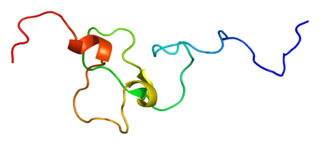Brain-specific angiogenesis inhibitor 1 is a protein that in humans is encoded by the BAI1 gene. [5] [6] It is a member of the adhesion-GPCR family of receptors. [7]
Brain-specific angiogenesis inhibitor 1 is a protein that in humans is encoded by the BAI1 gene. [5] [6] It is a member of the adhesion-GPCR family of receptors. [7]
Angiogenesis is controlled by a local balance between stimulators and inhibitors of new vessel growth and is suppressed under normal physiologic conditions. Angiogenesis has been shown to be essential for growth and metastasis of solid tumors. In order to obtain blood supply for their growth, tumor cells are potently angiogenic and attract new vessels as results of increased secretion of inducers and decreased production of endogenous negative regulators. BAI1 contains at least one 'functional' p53-binding site within an intron, and its expression has been shown to be induced by wildtype p53. There are two other brain-specific angiogenesis inhibitor genes, designated BAI2 and BAI3 which along with BAI1 have similar tissue specificities and structures, however only BAI1 is transcriptionally regulated by p53. BAI1 is postulated to be a member of the secretin receptor family, an inhibitor of angiogenesis and a growth suppressor of glioblastomas. [6]
Brain-specific angiogenesis inhibitor 1 has been shown to interact with BAIAP3 [8] and MAGI1. [9]

p53, also known as Tumor protein P53, cellular tumor antigen p53, or transformation-related protein 53 (TRP53) is a regulatory protein that is often mutated in human cancers. The p53 proteins are crucial in vertebrates, where they prevent cancer formation. As such, p53 has been described as "the guardian of the genome" because of its role in conserving stability by preventing genome mutation. Hence TP53 is classified as a tumor suppressor gene.

Phorbol-12-myristate-13-acetate-induced protein 1 is a protein that in humans is encoded by the PMAIP1 gene, and is also known as Noxa.

Afadin is a protein that in humans is encoded by the AFDN gene.

Brain-specific angiogenesis inhibitor 2 is a protein that in humans is encoded by the BAI2 gene. It is a member of the adhesion-GPCR family of receptors.

Brain-specific angiogenesis inhibitor 3 is a protein that in humans is encoded by the BAI3 gene.

DNA-binding protein inhibitor ID-1 is a protein that in humans is encoded by the ID1 gene.
Brain-specific angiogenesis inhibitors are G-protein coupled receptors belonging to the class B secretin subfamily. Members include:

Brain-specific angiogenesis inhibitor 1-associated protein 2 is a protein that in humans is encoded by the BAIAP2 gene.

Metastasis-associated protein MTA2 is a protein that in humans is encoded by the MTA2 gene.

Membrane-associated guanylate kinase, WW and PDZ domain-containing protein 1 is an enzyme that in humans is encoded by the MAGI1 gene.

RING finger and CHY zinc finger domain-containing protein 1 is a protein that in humans is encoded by the RCHY1 gene.

Inhibitor of growth protein 4 is a protein that in humans is encoded by the ING4 gene.

Disks large-associated protein 1 (DAP-1), also known as guanylate kinase-associated protein (GKAP), is a protein that in humans is encoded by the DLGAP1 gene. DAP-1 is known to be highly enriched in synaptosomal preparations of the brain, and present in the post-synaptic density.

Membrane-associated guanylate kinase, WW and PDZ domain-containing protein 2 also known as membrane-associated guanylate kinase inverted 2 (MAGI-2) and atrophin-1-interacting protein 1 (AIP-1) is an enzyme that in humans is encoded by the MAGI2 gene.
TGFB1-induced anti-apoptotic factor 1 is a protein that in humans is encoded by the TIAF1 gene.

Myosin-XVIIIa is a protein that in humans is encoded by the MYO18A gene.

BAI1-associated protein 3 is a protein that in humans is encoded by the BAIAP3 gene.

Neurogenic differentiation factor 2 is a protein that in humans is encoded by the NEUROD2 gene.

P2X purinoceptor 6 is a protein that in humans is encoded by the P2RX6 gene.

p53-regulated apoptosis-inducing protein 1 is a protein that in humans is encoded by the TP53AIP1 gene.
This article incorporates text from the United States National Library of Medicine, which is in the public domain.